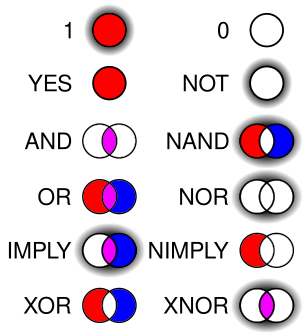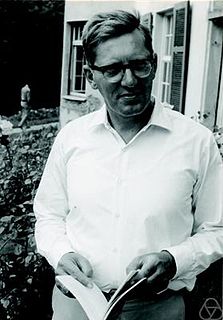Related Research Articles
Automated theorem proving is a subfield of automated reasoning and mathematical logic dealing with proving mathematical theorems by computer programs. Automated reasoning over mathematical proof was a major impetus for the development of computer science.
Lambda calculus is a formal system in mathematical logic for expressing computation based on function abstraction and application using variable binding and substitution. It is a universal model of computation that can be used to simulate any Turing machine. It was introduced by the mathematician Alonzo Church in the 1930s as part of his research into the foundations of mathematics.
In mathematics, logic, and computer science, a type system is a formal system in which every term has a "type" which defines its meaning and the operations that may be performed on it. Type theory is the academic study of type systems.

Haskell Brooks Curry was an American mathematician and logician. Curry is best known for his work in combinatory logic. While the initial concept of combinatory logic was based on a single paper by Moses Schönfinkel, Curry did much of the development. Curry is also known for Curry's paradox and the Curry–Howard correspondence. There are three programming languages named after him, Haskell, Brook and Curry, as well as the concept of currying, a technique used for transforming functions in mathematics and computer science.
Intuitionistic logic, sometimes more generally called constructive logic, refers to systems of symbolic logic that differ from the systems used for classical logic by more closely mirroring the notion of constructive proof. In particular, systems of intuitionistic logic do not include the law of the excluded middle and double negation elimination, which are fundamental inference rules in classical logic.
Proof theory is a major branch of mathematical logic that represents proofs as formal mathematical objects, facilitating their analysis by mathematical techniques. Proofs are typically presented as inductively-defined data structures such as plain lists, boxed lists, or trees, which are constructed according to the axioms and rules of inference of the logical system. As such, proof theory is syntactic in nature, in contrast to model theory, which is semantic in nature.
In programming language theory and proof theory, the Curry–Howard correspondence is the direct relationship between computer programs and mathematical proofs.
In the context of hardware and software systems, formal verification is the act of proving or disproving the correctness of intended algorithms underlying a system with respect to a certain formal specification or property, using formal methods of mathematics.
In theoretical computer science, correctness of an algorithm is asserted when it is said that the algorithm is correct with respect to a specification. Functional correctness refers to the input-output behavior of the algorithm.
In mathematics, a constructive proof is a method of proof that demonstrates the existence of a mathematical object by creating or providing a method for creating the object. This is in contrast to a non-constructive proof, which proves the existence of a particular kind of object without providing an example. For avoiding confusion with the stronger concept that follows, such a constructive proof is sometimes called an effective proof.

Coq is an interactive theorem prover first released in 1989. It allows for the expression of mathematical assertions, mechanically checks proofs of these assertions, helps to find formal proofs, and extracts a certified program from the constructive proof of its formal specification. Coq works within the theory of the calculus of inductive constructions, a derivative of the calculus of constructions. Coq is not an automated theorem prover but includes automatic theorem proving tactics (procedures) and various decision procedures.
In logic, a logical framework provides a means to define a logic as a signature in a higher-order type theory in such a way that provability of a formula in the original logic reduces to a type inhabitation problem in the framework type theory. This approach has been used successfully for (interactive) automated theorem proving. The first logical framework was Automath; however, the name of the idea comes from the more widely known Edinburgh Logical Framework, LF. Several more recent proof tools like Isabelle are based on this idea. Unlike a direct embedding, the logical framework approach allows many logics to be embedded in the same type system.
Categorical logic is the branch of mathematics in which tools and concepts from category theory are applied to the study of mathematical logic. It is also notable for its connections to theoretical computer science. In broad terms, categorical logic represents both syntax and semantics by a category, and an interpretation by a functor. The categorical framework provides a rich conceptual background for logical and type-theoretic constructions. The subject has been recognisable in these terms since around 1970.

Logic in computer science covers the overlap between the field of logic and that of computer science. The topic can essentially be divided into three main areas:
In computer science and logic, a dependent type is a type whose definition depends on a value. It is an overlapping feature of type theory and type systems. In intuitionistic type theory, dependent types are used to encode logic's quantifiers like "for all" and "there exists". In functional programming languages like Agda, ATS, Coq, F*, Epigram, and Idris, dependent types may help reduce bugs by enabling the programmer to assign types that further restrain the set of possible implementations.

Nicolaas Govert (Dick) de Bruijn was a Dutch mathematician, noted for his many contributions in the fields of analysis, number theory, combinatorics and logic.
In computer science, termination analysis is program analysis which attempts to determine whether the evaluation of a given program halts for each input. This means to determine whether the input program computes a total function.
In computer science, lambda calculi are said to have explicit substitutions if they pay special attention to the formalization of the process of substitution. This is in contrast to the standard lambda calculus where substitutions are performed by beta reductions in an implicit manner which is not expressed within the calculus. The concept of explicit substitutions has become notorious because the notion often turns up in formal descriptions and implementation of all the mathematical forms of substitution involving variables such as in abstract machines, predicate logic, and symbolic computation.
In the branches of mathematical logic known as proof theory and type theory, a pure type system (PTS), previously known as a generalized type system (GTS), is a form of typed lambda calculus that allows an arbitrary number of sorts and dependencies between any of these. The framework can be seen as a generalisation of Barendregt's lambda cube, in the sense that all corners of the cube can be represented as instances of a PTS with just two sorts. In fact, Barendregt (1991) framed his cube in this setting. Pure type systems may obscure the distinction between types and terms and collapse the type hierarchy, as is the case with the calculus of constructions, but this is not generally the case, e.g. the simply typed lambda calculus allows only terms to depend on terms.
The type theory was initially created to avoid paradoxes in a variety of formal logics and rewrite systems. Later, type theory referred to a class of formal systems, some of which can serve as alternatives to naive set theory as a foundation for all mathematics.
References
- ↑ Morten Heine Sørensen, Paweł Urzyczyn, Lectures on the Curry–Howard isomorphism, Elsevier, 2006, ISBN 0-444-52077-5, pp 98-99
- ↑ R. P. Nederpelt, J. H. Geuvers, R. C. de Vrijer (1994) Selected Papers on Automath. Vol. 133 of Studies Logic, Elsevier, Amsterdam. ISBN 0-444-89822-0.
- ↑ F. Kamareddine (2003) Thirty-five years of automating mathematics. Workshop, Dordrecht, Boston, published by Kluwer Academic Publishers, ISBN 1-4020-1656-5.